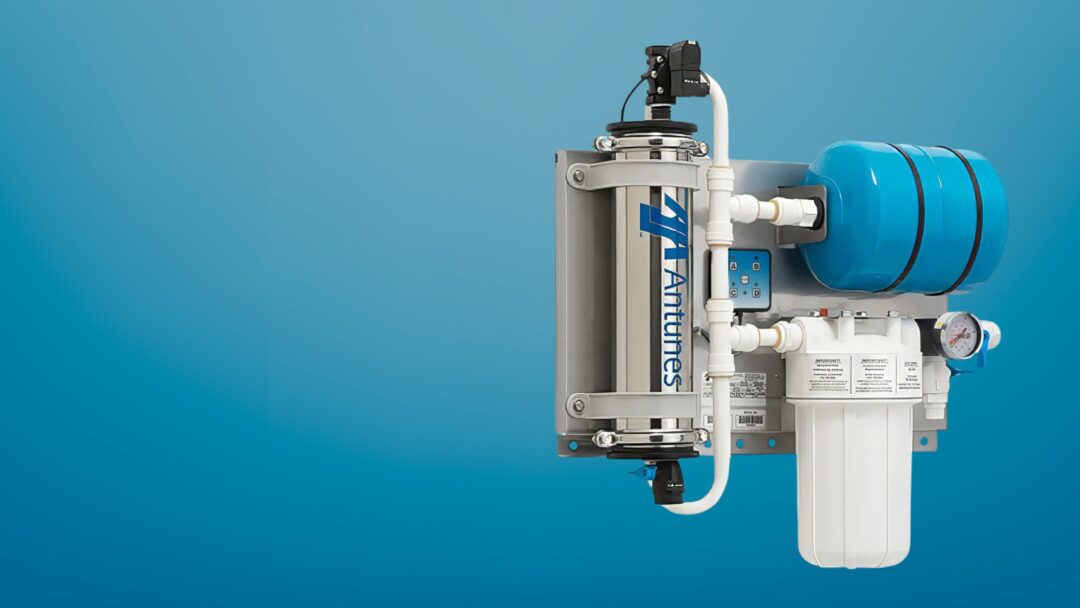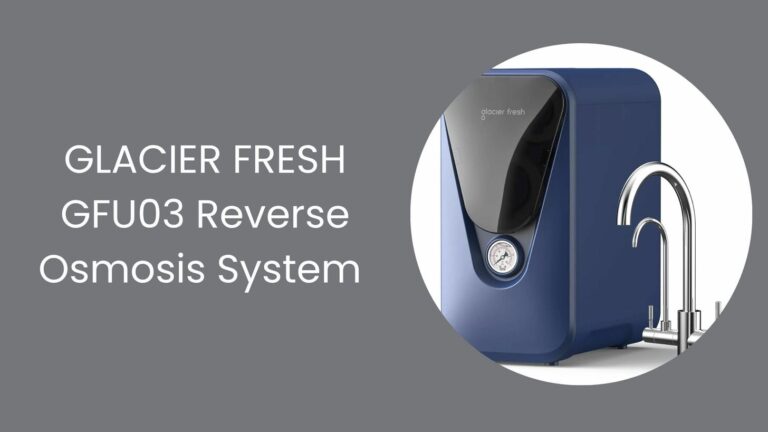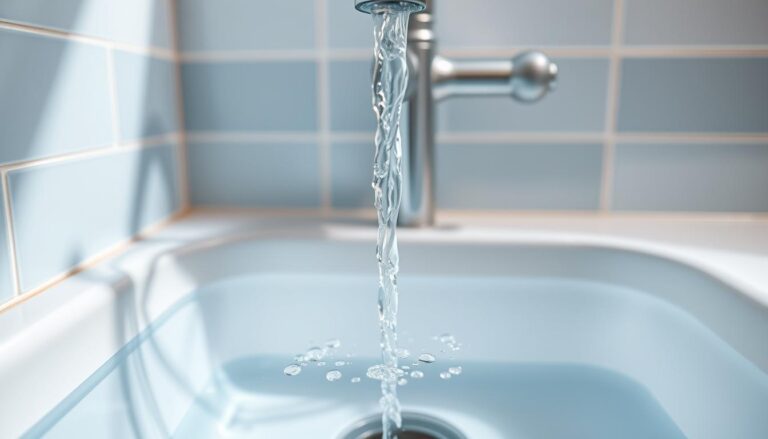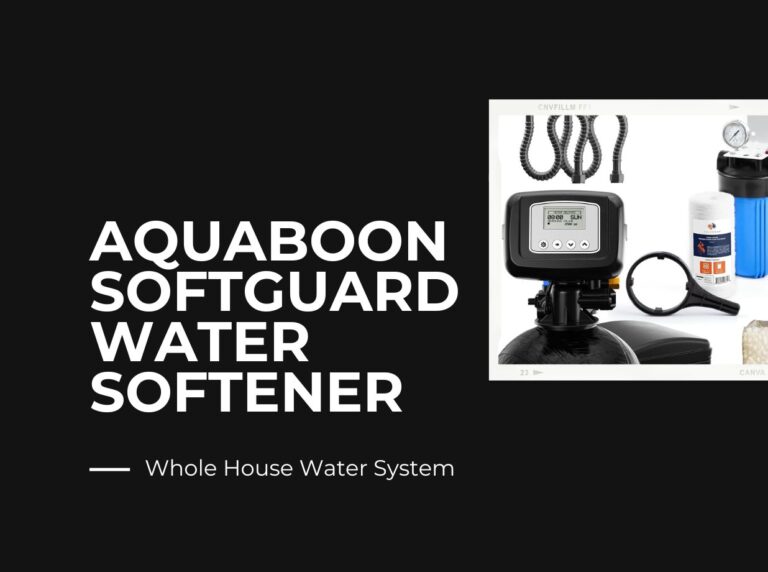What is Template Assisted Crystallization (TAC)?
Are you tired of dealing with scale buildup in your home’s water pipes? Scale buildup can lead to reduced water pressure, increased energy bills, and even damage to your plumbing system. Template Assisted Crystallization (TAC) is a technology used in home water treatment to prevent this issue.
TAC is a innovative solution that helps to reduce scale buildup by converting minerals into harmless crystals that don’t stick to surfaces. This results in cleaner, healthier water and a longer lifespan for your plumbing system.
Key Takeaways
- TAC stands for Template Assisted Crystallization, a technology used in home water treatment.
- TAC helps to prevent scale buildup in water pipes.
- The technology converts minerals into harmless crystals.
- TAC results in cleaner, healthier water and a longer lifespan for plumbing systems.
- It’s an innovative solution for reducing maintenance costs.
Understanding TAC in Home Water Treatment
Template Assisted Crystallization (TAC) is revolutionizing the way we approach water treatment in our homes. At its core, TAC is a technology designed to address the issues caused by hard water, which can lead to scale buildup and damage to plumbing and appliances.
Definition and Basic Principles of TAC
TAC works by using a catalyst to create nano-sized scale crystals that won’t stick to surfaces, thus preventing the formation of hard scale. This process is based on the principle of crystallization, where the catalyst templates the crystallization of minerals, resulting in harmless, non-adhesive crystals.
The Origin of Template Assisted Crystallization
TAC technology was first employed in Germany about 15 years ago. It was later introduced to the U.S. and Canada, where it has gained popularity as an effective solution for hard water problems. The technology has been refined over the years to improve its efficiency and effectiveness.
How TAC Addresses Hard Water Problems
Hard water contains high levels of minerals such as calcium and magnesium, which can cause scaling. TAC addresses this issue by converting these minerals into a crystalline form that doesn’t adhere to surfaces. This not only prevents scale buildup but also helps in reducing the maintenance costs associated with hard water.
As noted by industry experts, “TAC is a significant advancement in water treatment technology, offering a salt-free and environmentally friendly solution to hard water problems.”
| Key Benefits | Description |
|---|---|
| Scale Prevention | TAC prevents scale buildup by converting minerals into non-adhesive crystals. |
| Salt-Free | Unlike traditional water softeners, TAC does not use salt, making it an eco-friendly option. |
| Low Maintenance | TAC systems require minimal maintenance, as they do not need regeneration like salt-based softeners. |
What is TAC in Home Water Treatment?
With its origins in industrial applications, TAC technology has evolved significantly to meet the needs of home water treatment. The importance of TAC in home water purification lies in its ability to condition water without removing beneficial minerals, making it a preferred choice for many homeowners.
The Evolution of TAC Technology
TAC technology has undergone significant transformations since its inception. Initially used in industrial settings, it has been adapted for home use, offering a reliable solution for water treatment.
From Industrial Applications to Home Use
The transition of TAC technology from industrial to domestic use has been driven by advancements in design and functionality. Modern TAC systems are designed to be compact and efficient, making them suitable for home installation.
Modern Advancements in TAC Systems
Recent advancements in TAC technology have focused on improving efficiency and effectiveness. These advancements include enhanced template designs and more robust materials, contributing to the overall performance of TAC systems.
| Feature | Industrial TAC | Home TAC |
|---|---|---|
| Scale Prevention | Effective in large systems | Effective in residential plumbing |
| Installation | Complex, requiring professional installation | Simplified for DIY or professional installation |
| Maintenance | Regular maintenance required | Low maintenance, easy to service |
The evolution of TAC technology has made it an integral part of home water treatment, offering a salt-free solution for scale prevention. As the technology continues to advance, we can expect even more efficient and effective TAC systems in the future.
How TAC Water Treatment Systems Work
Understanding how TAC systems work requires a look into the Template Assisted Crystallization process. TAC water treatment systems are designed to prevent scale buildup by altering the structure of minerals in the water.
The Template Assisted Crystallization Process
The Template Assisted Crystallization (TAC) process is a technology used in water treatment to reduce scale formation. It works by providing nucleation sites for the crystallization of calcium and magnesium, the primary components of scale.
The Role of Nucleation Sites
Nucleation sites are crucial in the TAC process. These sites, provided by the TAC media, allow calcium and magnesium ions to crystallize, forming harmless crystals that do not adhere to surfaces, thus preventing scale buildup.
Calcium and Magnesium Crystal Formation
The crystallization of calcium and magnesium ions results in the formation of stable crystals. This process not only prevents scale buildup but also maintains the beneficial minerals in the water, making it a healthier alternative to traditional water softening methods.
| Process | Description | Benefit |
|---|---|---|
| Template Assisted Crystallization | Uses specialized media to provide nucleation sites | Prevents scale buildup |
| Nucleation Sites Provision | Allows crystallization of calcium and magnesium | Maintains beneficial minerals |
| Crystal Formation | Results in stable crystals | Reduces scaling on surfaces |
TAC for water softening is an effective method that not only reduces scale formation but also preserves the natural minerals in the water, making it a preferred choice for many homeowners.
Benefits of TAC Water Treatment for Homeowners
TAC water treatment offers numerous advantages for homeowners, enhancing their water quality and appliance longevity. By adopting TAC technology, homeowners can experience significant improvements in their water treatment systems.
The Template Assisted Crystallization (TAC) process is a revolutionary method that treats water without the need for salt, making it an eco-friendly alternative to traditional water softeners. One of the primary benefits of TAC water treatment is its ability to prevent scale buildup.
Scale Prevention Without Salt
TAC systems achieve scale prevention through a chemical-free process, crystallizing minerals in the water, which are then harmlessly flushed away. This method not only reduces scale buildup but also maintains the health benefits of minerals in the water.
Protection for Pipes and Fixtures
By preventing scale buildup, TAC water treatment protects pipes and fixtures from damage, reducing the need for costly repairs and replacements. This protection extends the lifespan of plumbing systems, ensuring they remain efficient and functional.
Extended Appliance Lifespan
TAC water treatment also benefits household appliances by reducing the impact of scale buildup on their internal mechanisms. With TAC, appliances such as water heaters, dishwashers, and coffee makers can operate more efficiently and last longer, providing homeowners with significant cost savings over time.
In conclusion, TAC water treatment provides homeowners with a range of benefits, from scale prevention and protection for pipes and fixtures to extended appliance lifespan. By choosing TAC, homeowners can enjoy better water quality, reduced maintenance costs, and an eco-friendly solution to their water treatment needs.
Common Applications of TAC in Residential Settings
Residential water treatment has seen a significant shift with TAC technology. TAC systems are widely adopted in homes due to their effectiveness in preventing scale buildup without the need for salt. This makes them an attractive option for homeowners looking for a low-maintenance solution.
Whole-House Water Treatment
One of the primary applications of TAC is in whole-house water treatment systems. These systems are designed to treat all the water in a home, providing comprehensive protection against scale buildup. By installing a TAC system at the point of entry, homeowners can ensure that all water outlets in the house are treated.
Point-of-Entry Installation Benefits
Installing a TAC system at the point of entry offers several benefits. It ensures that all water entering the home is treated, reducing the risk of scale buildup in pipes, appliances, and fixtures. This can lead to significant savings on maintenance and repair costs over time.
Comprehensive Home Protection
A whole-house TAC system provides comprehensive protection for the home. By preventing scale buildup, it helps to extend the lifespan of plumbing, water heaters, and appliances. This means that homeowners can enjoy peace of mind knowing that their home is protected from the damaging effects of hard water.
Furthermore, TAC systems are designed to be efficient and require minimal maintenance, making them a convenient choice for homeowners. The TAC measurement in home filtration systems is crucial for ensuring the effectiveness of the treatment process.
In conclusion, TAC systems are a popular choice for residential water treatment due to their effectiveness and low maintenance requirements. By understanding TAC levels in water treatment, homeowners can make informed decisions about their water treatment needs.
TAC vs. Traditional Water Softeners
When it comes to managing water hardness, homeowners have two primary options: TAC water treatment systems and traditional water softeners. The choice between these two technologies depends on several factors, including effectiveness, maintenance requirements, and environmental impact.
TAC systems condition water without removing minerals, whereas traditional water softeners remove minerals using ion exchange. This fundamental difference affects how each system operates and its overall benefits.
Salt-Based Softeners: Pros and Cons
Traditional water softeners often rely on salt to facilitate the ion exchange process. While effective in removing minerals that cause water hardness, these systems have their drawbacks.
Effectiveness in Mineral Removal
Salt-based softeners are highly effective in removing calcium and magnesium ions, which are the primary causes of water hardness. However, this process also removes beneficial minerals, potentially affecting the taste and quality of the water.
Maintenance Requirements and Environmental Impact
These systems require regular maintenance, including salt replenishment and cleaning. The environmental impact is also a concern due to the salt discharge into wastewater, which can affect aquatic ecosystems.
| Feature | TAC Systems | Traditional Water Softeners |
|---|---|---|
| Mineral Removal | No | Yes |
| Salt Usage | No | Yes |
| Maintenance Frequency | Low | High |
| Environmental Impact | Low | Moderate to High |
Understanding the differences between TAC and traditional water softeners is crucial for homeowners to make an informed decision that suits their needs and preferences.
Measuring and Monitoring TAC Effectiveness
The effectiveness of TAC in home water filtration systems can be accurately assessed through systematic water testing. This process involves evaluating the water quality before and after treatment to determine the system’s impact on water hardness and overall quality.
Testing Water Before and After Treatment
To effectively measure TAC effectiveness, it’s essential to conduct thorough water tests both before and after the treatment process. This comparative analysis helps in understanding the system’s efficiency in reducing water hardness and improving overall water quality.
DIY Water Hardness Testing Methods
For homeowners who prefer a hands-on approach, DIY water hardness testing kits are available. These kits usually include test strips or titration-based tests that can provide a basic indication of water hardness levels.
Professional Water Analysis Options
For a more detailed and accurate assessment, professional water analysis is recommended. Laboratories can conduct comprehensive tests to measure various water quality parameters, including hardness, pH levels, and the presence of other minerals.
Here’s a comparison of DIY and professional water testing methods:
| Testing Method | Accuracy | Cost |
|---|---|---|
| DIY Testing Kits | Moderate | Low |
| Professional Water Analysis | High | Moderate to High |
Regular monitoring of TAC system effectiveness is crucial to ensure that the system continues to perform optimally over time. By combining initial testing with ongoing monitoring, homeowners can maximize the benefits of TAC in their home water filtration systems.
Installation Considerations for TAC Systems
Understanding the installation requirements of TAC systems is crucial for their optimal performance. The effectiveness of a TAC water treatment system largely depends on its installation. Homeowners must consider several factors when deciding how to install their TAC system.
Professional vs. DIY Installation
TAC systems can be installed either professionally or through DIY methods, depending on the homeowner’s preference and the complexity of their plumbing system. Professional installation ensures that the system is set up correctly and functions as intended, while DIY installation can be cost-effective for those with plumbing experience.
When to Call a Professional
It’s recommended to call a professional if you have a complex plumbing system or are unsure about any aspect of the installation. Professionals can ensure that the TAC system is integrated correctly with your existing plumbing, minimizing potential issues.
DIY Installation Steps Overview
For those opting for DIY installation, the process typically involves shutting off the main water supply, cutting into the main water line, and installing the TAC system according to the manufacturer’s instructions. It’s essential to follow the manufacturer’s guidelines carefully to avoid any mistakes.
| Installation Method | Pros | Cons |
|---|---|---|
| Professional Installation | Ensures correct setup, minimizes potential issues | Higher upfront cost |
| DIY Installation | Cost-effective, allows for personal control | Requires plumbing knowledge, potential for installation errors |
In conclusion, the choice between professional and DIY installation for TAC systems depends on the homeowner’s comfort level with plumbing and their specific situation. Regardless of the method chosen, following the manufacturer’s instructions and considering the complexity of the plumbing system are key to a successful installation.
Maintenance Requirements for TAC Water Treatment Systems
Maintaining your TAC water treatment system is essential for its longevity and effectiveness. Regular maintenance ensures that the system continues to provide high-quality water by preventing scale buildup and maintaining the integrity of the treatment media.
Routine maintenance is crucial for the optimal functioning of TAC systems. This includes checking the system’s performance regularly and replacing the media every 3 to 5 years, depending on water conditions.
Routine Maintenance Schedule
To keep your TAC system in top condition, it’s essential to follow a routine maintenance schedule. This involves both monthly and annual tasks to ensure the system operates efficiently.
Monthly and Annual Maintenance Tasks
Monthly tasks include checking the system’s flow rate and inspecting for any signs of wear or damage. Annually, it’s recommended to perform a more thorough inspection, including checking the condition of the media and ensuring all connections are secure.
System Performance Monitoring
Monitoring the performance of your TAC system is vital to ensure it’s working effectively. This involves regularly testing the water quality before and after treatment to verify that the system is removing scale-causing minerals as expected.
Regular maintenance not only extends the lifespan of your TAC system but also ensures that you continue to enjoy the benefits of scale-free water. By staying on top of maintenance tasks, homeowners can maximize the efficiency and effectiveness of their TAC water treatment systems.

Common Misconceptions About TAC Water Treatment
Despite its growing popularity, TAC water treatment is surrounded by several myths and misconceptions. Many homeowners are confused about how TAC works and its benefits. It’s essential to address these misconceptions to provide clarity on the effectiveness of TAC water treatment systems.
Debunking TAC Myths
TAC technology is often misunderstood due to a lack of information or misinformation. Let’s examine some common myths associated with TAC water treatment.
“TAC Removes Minerals from Water” Myth
The notion that TAC removes minerals from water is a common misconception. In reality, TAC systems alter the structure of minerals to prevent scaling, without removing them from the water. This process ensures that the water retains its mineral content while becoming more efficient for household use.
“TAC is the Same as Water Softening” Myth
Another myth is that TAC is equivalent to traditional water softening. However, TAC and water softening are distinct processes. While water softening typically involves removing minerals like calcium and magnesium, TAC changes the form of these minerals to prevent scale buildup, without removing them. This fundamental difference is crucial for understanding the unique benefits of TAC.
Some key differences between TAC and traditional water softening include:
- TAC does not use salt, making it a more environmentally friendly option.
- TAC retains beneficial minerals in the water.
- TAC prevents scale buildup without removing minerals.
By understanding the facts behind TAC water treatment, homeowners can make informed decisions about their water treatment needs. It’s crucial to rely on credible sources of information to avoid falling prey to common misconceptions about TAC.
Conclusion: Is TAC Right for Your Home Water Treatment Needs?
TAC water conditioners offer a viable solution for homeowners seeking to prevent scale buildup without using salt or removing beneficial minerals. By understanding what TAC is in home water, homeowners can make informed decisions about their water treatment needs.
TAC benefits include effectiveness in removing up to 99% of calcium and magnesium ions, handling flow rates of up to 15 gallons per minute, and reducing scaling by up to 90%. With minimal power consumption and no need for salt or chemicals, TAC systems are an efficient choice for medium to large households.
When considering a TAC water conditioner, factors such as effectiveness, ease of installation, cost-effectiveness, and brand reputation are crucial. Popular models like TAC3M, TAC5M, TAC1000, TAC2000, and TAC3000 offer unique features that cater to different household needs.
Ultimately, TAC water treatment is a suitable option for those looking for a low-maintenance, eco-friendly solution. By weighing the benefits and considering specific household requirements, homeowners can determine if TAC is the right choice for their water treatment needs.







